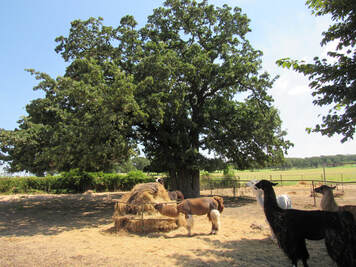|
Most llama breeding farms, whether they have 5 females or 50 females, end up housing multiple llama studs. Having options when making breeding choices is too exciting of an opportunity to pass up, and then the question becomes, “where do I keep them?” In this article, we will share ideas from the many farms we’ve visited in recent years, as well as ideas from our own small acreage farm. This article is from American Llama Sires: Issue 7. The full article features additional photos and tips for keeping llama studs. Click here to read American Llama Sires  Males housed together at Triple V Ranch Males housed together at Triple V Ranch It is important to keep male llamas separate from females so that breedings can be scheduled, and injury and infection can be prevented in the females. Male llamas will also breed young females before they are physically ready to be bred. So, once you've decided to pasture your males separately you have to decide on the following:
The first thing to decide is if you’ll let the males stay together, leaving you to put up with the occasional wrestling and spitting matches. While there are people who are still doing this effectively, it seems to be a less common approach than it used to be. Of the farms we’ve visited in recent years, Rick and Sharon VanHooser of Triple V Ranch are the only ones who kept intact males together. They also had far and away the most breeding males to choose from on their farm, with more than 20 proven males. They have three or four groups of males, so they are able to swap boys out to find the perfect mix of personalities. There were a few males who were kept on their own, presumably because they don’t play nice with others. Whatever they are doing is working, because I don’t think we saw a male give another male a dirty look while we were in Texas. Some males do better with sharing their space than others, and even the most mild-mannered of males will occasionally have wrestling matches to shake up the pecking order. Some of the things to keep in mind if you are going to house your males together include:
 Mark and Susan Smith's Stud Barn Mark and Susan Smith's Stud Barn Together or Separate - Part II If you decide to put your males in separate pastures, you then have to decide where to put those pastures. Here again the question becomes- together or separate? The majority of the farms we visit choose to pasture their males separately, but condense them in a specific area, typically with some separation from the females. Mark and Susan Smith have a separate barn where they house the majority of their males. It is off to one side of their property, behind their house. There is a garden patch, a driveway, and a large backyard between the males and the female herd. Three studs are kept in stud runs with gravel. I am sure the males have “disagreements” over the fence from time to time, but with the females so far away this is kept to a minimum. Also housed in the male barn is the Smiths’ sheep herd. When we visited a couple of years ago the sheep were sharing their pasture with a couple of yearling males.  Wild Oak Llamas property with males on one side of the driveway, and females on the other. Wild Oak Llamas property with males on one side of the driveway, and females on the other. Rick and Mary Adams keep their males on one side of their driveway, and their females on the other. Tall, strong fences separate the boys, who occasionally run up and down the fence lines contentiously. They also have a large pasture that surrounds the male pastures where Mary’s old show gelding and a couple of younger or more docile herdsires are housed.  GNLC Tesio in his stud pen at Great Northern Ranch GNLC Tesio in his stud pen at Great Northern Ranch Very Separate On our farm, we keep our males in separate pastures, and have spread those pastures out around the property. While this provides the lowest chance of fighting between males, and helps keep your farm a more peaceful place, it does come with its share of drawbacks. The downsides of spreading out your males include:
We hope that this article helps you to plan out your setup as you consider that proverbial question, “Do we have room for one more male?” This article is from American Llama Sires: Issue 7. The full article features additional photos and tips for keeping llama studs. Click here to read American Llama Sires
0 Comments
Your comment will be posted after it is approved.
Leave a Reply. |
AuthorKyle Mumford is a third generation llama owner, and his family has owned llamas since 1980. Kyle and his wife Jerrika have a herd of approximately 25 llamas in Southwest Washington. Categories
All
|
 RSS Feed
RSS Feed